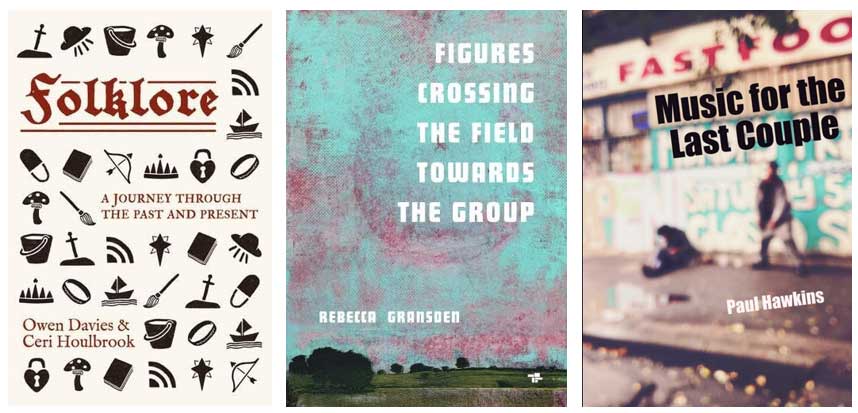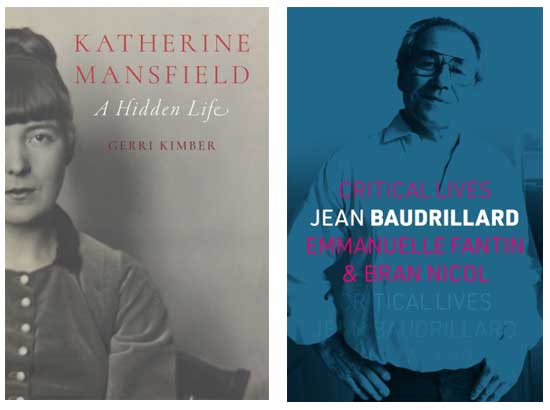
Folklore, Owen Davies & Ceri Houlbrook (Manchester University Press)
Figures Crossing the Field Towards The Group, Rebecca Gransden (The Tangerine Press)
Music For The Last Couple, Paul Hawkins (Steel Incisors)
Katherine Mansfield: A Hidden Life, Gerri Kimber (Reaktion Books)
Jean Baudrillard, Emmanuelle Fantin and Bran Nicol (Reaktion Books)
There have been a lot of recent publications about folk customs and beliefs (some are reviewed here and here) but Folklore is by far the best I have come across. Owen Davies and Ceri Houlbrook explore their subject matter through a series of umbrella titles such as ‘Stories’, ‘Environment’ and ‘Spiritual life’ which allow for a kind of thematic survey, but also aren’t afraid to grapple with contemporary issues and interpretations of the past: as the book goes on it embraces ‘Modern media’ and ‘Identity’.
So this is not a nostalgic dewy-eyed romp around the maypole, it considers Brexit and xenophobia, the debunking of many assumed histories and isn’t afraid to point out that many “traditions” were recently invented. None of that changes the fact that they are useful community events or happening, often with spiritual, occult and religious meanings, always with some sense of longing for something new or other. The book’s subtitle is ‘A journey through the past and present’ and for once it is an accurate description. History, sociology, mythology, fairytales, games, pastimes, dancing and drunkenness, mystery and magic all feature here in a highly readable, thorough and engaging book.
Rebecca Gransden’s book has little to do with folklore but it is a self-mythologising post-apocalyptic novel. It is a pilgrimage of sorts, but a negative one: Flo is running away from ‘the red’ which is spreading from the South to the North. The red seems to be a physical illness, an electronic or media virus, a hum, perhaps even a mass hallucination. There is a dreamlike quality to this journey, aided by the fact that language itself is mutating, and the story is only narrated in words of one syllable, although reported speech does not seem affected. Nor, apparently, are the observers whose reports are filed in the ‘PUBLIC INFORMATION DREAMS’ chapter.
It feels like a poetic prophecy for the UK. This is a mangled yet somehow hyper-realist and mundane future, where our contemporary society is shown to be useless and of little consequence, a failure in all sorts of ways. It is a non-epic version of a familiar story, an everyday retelling of Cormac McCarthy’s The Road perhaps, but neither as grim nor as optimistic. Flo may be lost and confused, but she lives in the moment; there may be a brutal ending to this tale, but it appears that – either physically or metaphorically – she flees and transcends the ‘brute camp’ she finds by the coast. It is a beautiful, elegaic novella, one of the best books I have read in the last few years.
And Paul Hawkins’ Music For The Last Couple is another, yet very different. If Gransden’s book is mournful and slow, Hawkins’ is jagged and pulsating, a mutated dance music with high BPM. Sentence after sentence, image after image, accumulate, each modifying the one before, each a standalone statement immediately superseded by the next. Characters appear then disappear; wars, violence, love affairs and music come and go; technology fails, alarms go off, trauma-based psychology appears to be on offer for everyone.
The staccato sentences implode and rub against each other in the mental wreckage, the burnt memories of a travelogue or road trip, leaving the reader to assemble their own impossible and variant narratives. Each page is also home to an AI photo generated by selected word prompt from the text. I am surprised the computer programme didn’t explode as it struggled to produce photos that mirrored the mutating slippage and juxtaposition of the urban, dystopian, fractured text. Impossible landscapes, collaged faces, missing shadows and obsessive hallucinations are on offer, often in industrial ruins or war zones, sometimes in unworldly negative spaces. Time it seems has ended, or sped up, or simply eaten itself. This is a text that never stops changing as one tries to read it, an immersive, puzzling and fascinating book.

What we often think of as experimental fiction, usually considered as part of Modernism at the end of the 19th Century and into the 20th, would not have happened without Katherine Mansfield. She realised that readers could work out narrative that existed outside episodes of a character’s life, or from multiple viewpoints around a place and/or those events. Her book In a German Pension did just that, presented a number of interlinked stories that moved in time and point-of-view. Her other short stories, were similarly quietly experimental but would have a lasting influence on narrative in creative writing.
Gerri Kimber embeds her readings of Mansfield’s stories within a fairly traditional biography, but she is keen to emphasise originality and innovation. Mansfield grew up in New Zealand but moved to London in her early teens and then again, having toured Europe and then returned ‘home’, in 1908. She soon adopted a bohemian lifestyle and became friends with other authors such as D.H. Lawrence, Aldous Huxley, T.S. Eliot and a rival to Virginia Woolf. Her bisexuality, impetuous love life and perceptive literary explorations of psychology and existentialism, gave an inquiring backbone to her writing, one that she would persist with to the end of her brief life (she died aged 34) as she produced new fiction in London and Cornwall and then in France and Switzerland, where she sought out unorthodox and ineffective cures for the tuberculosis which would eventually kill her.
The postmodernist philosopher Jean Baudrillard’s work is perhaps pertinent as a way of understanding works like Gransden’s and Hawkins’, where we are presented with hyperreal simulations of events, an idea Baudrillard wrote about in relation to both the Gulf War and 9/11. He maintained that we only saw a media version of these events (building upon ideas rooted in Guy Debord’s Society of the Spectacle) and questioned whether they really happened at all. This was, of course, a provocation, and Baudrillard always maintained that his ideas of ‘simulacra’ were misunderstood and misapplied by readers, critics and intellectuals.
Perhaps more important was his ability to question in a way that provoked different ways of thinking, to defamiliarize everyday and commonly accepted attitudes, responses to and interpretations of events. He did this most famously in his Cool Memories series of books, where he considered his USA road trips, visits and travels in terms of transience and being an outsider, presenting his defamiliarized opinions (edited from comprehensive notebooks) back to an uncomprehending American readership. Jean Baudrillard is one of Reaktion Books’ Critical Lives series, and continues the list’s focus on how biography informs the writing of each volume’s subject rather than biography for biography’s sake. Baudrillard’s theories, particularly his critiques of systems failing and outgrowing both themselves and their usefulness, along with his ideas of ‘extreme events’ triggering reversionings of history and new futures remain pertinent and thought-provoking. Like this book.
Rupert Loydell
